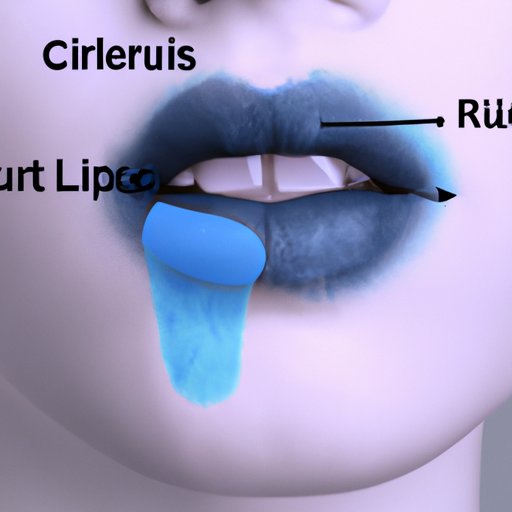I. Introduction
Blue lips are a concerning symptom that can be indicative of a serious underlying health issue. This article aims to explore the causes, treatments, and preventative measures of blue lips, and why it is essential to understand this symptom from a medical perspective.
II. Medical Conditions that May Cause Blue Lips
The medical conditions that may cause blue lips include cyanosis, Raynaud’s phenomenon, Chronic Obstructive Pulmonary Disease (COPD), and asthma.
1. Cyanosis: This is a medical condition characterised by a low concentration of oxygen in the blood. Cyanosis can present itself as blue lips, the result of lower oxygen levels in the bloodstream. Other symptoms of cyanosis may include blue skin on the fingers, toes or around the nose.
2. Raynaud’s Phenomenon: This phenomenon can result from stress or cold temperatures. Symptoms of Raynaud’s include stiffness or pain in the joints, and/or spasms in the blood vessels. Blue lips are another possible symptom.
3. Chronic Obstructive Pulmonary Disease (COPD): COPD is an umbrella term that includes emphysema, chronic bronchitis, and refractory asthma. COPD occurs when the airways in the lungs become damaged, making it difficult to breathe. Symptoms include coughing, wheezing, and shortness of breath, with blue lips being one of the observable symptoms.
4. Asthma: Asthma is a chronic respiratory condition that causes inflammation and constriction of the airways. In asthmatic individuals, blue lips are usually associated with a severe asthma attack, and are an indication that the lungs are having difficulty circulating oxygen to the rest of the body.
III. How to Recognise and Treat Blue Lips in Children and Adults
The recognition of blue lips is important for taking timely action. When blue lips appear in adults or children and the situation seems life-threatening, an ambulance should be called immediately. In most cases, the cause of blue lips is transient and will not require emergency treatment.
There is a wide range of underlying conditions that may cause blue lips in both adults and children. In some cases, blue lips may appear as an isolated symptom, while in others, there may be a combination of the symptoms mentioned above.
First aid treatment includes checking vital signs such as breathing and heart rate. First aiders should make sure the person is in a warm environment, as cold temperatures could worsen the situation and advise the affected individual to avoid stressful activities. If blue lips persist or are accompanied by difficulty breathing, seek immediate medical attention as the cause may be life-threatening.
IV. Blue Lips: A Possible Symptom of Hypothermia and Other Cold-related Conditions
Hypothermia can damage vital organs, particularly as body temperature drops lower. The most common symptoms of hypothermia include shivering, loss of coordination, and disorientation. Blue lips are one of the obvious symptoms of hypothermia, indicating an urgent need to seek medical treatment. Other cold-related conditions that may cause blue lips include frostbite and chilblains.
First aid treatment for hypothermia includes warming the affected individual, layering warm clothes, drinking warm fluids, and using external heat sources if available. Medical professionals may prescribe medications to manage hypothermia and other cold-related conditions in some cases.
V. Understanding the Role of Low Oxygen Levels in Blue Lips
The body requires oxygen to nourish vital organs and tissues. Low oxygen levels in the body may result in a range of medical conditions. Blue lips are one of the most visible indications of low oxygen levels in the bloodstream.
Low oxygen levels may result from a range of factors such as high altitudes or obstructed airways. Management of low oxygen levels primarily depends on the underlying condition causing it. In most cases, supplemental oxygen may be prescribed in addition to other treatment options.
VI. Preventing Blue Lips: Tips for Staying Safe and Warm in Cold Weather
Prevention is always better than treatment. In the cold weather, individuals should wear warm clothing, dress in layers, and adjust the number of layers according to the outside temperature. If an individual if at risk of developing hypothermia or frostbite, warm clothes, hats, and gloves must be worn. Before going out, it is important to check the weather forecast and dress appropriately.
Exercise can also help prevent hypothermia and frostbite. Moving around can increase blood flow, which in turn keeps the body’s organs and muscles warm. Regular aerobic exercise has been shown to promote blood flow, thereby, reducing the risk of hypothermia or frostbite.
VII. The Link between Blue Lips and Cardiovascular Disease
Certain types of cardiovascular diseases can result in blue lips. For example, heart failure may cause low oxygen levels in the bloodstream. Blue lips are a symptom of low oxygen levels, and thus could indicate the presence of heart disease. And Other cardiac diseases such as congenital heart defects and atrial septal defects can cause blue lips. Surgery may be necessary to correct them in these cases.

VIII. Exploring the Psychological and Emotional Impact of Blue Lips
The psychological and emotional impact of blue lips on individuals can be significant. Blue lips may affect an individual’s self-esteem, and ignite anxiety or depression in severe cases. Individuals who experience blue lips frequently should seek counselling support to help them cope and manage their emotions.
If blue lips are part of a more prolonged hospitalization, medical professionals may recommend specialized counselling services to people in recovery.
IX. Conclusion
Blue lips can be the indicator of undiagnosed, underlying, and life-threatening health conditions like hypothermia, cardiovascular disease, and/or respiratory issues. Any uncertainty should be immediately examined by a qualified healthcare professional. This article highlights the medical conditions that can cause blue lips, as well as first aid and treatment options for it.
To prevent blue lips, an individual should stay warm in cold temperatures, dress in layers, and avoid stressful activities in cold weather. Seeking immediate healthcare support is recommended if blue lips persists, in addition to seeking emotional support when necessary.
Medical Advice Disclaimer: The information contained in this article is intended as general guidance only. Please consult with a licensed medical professional for personalised advice regarding any medical conditions you may have.
